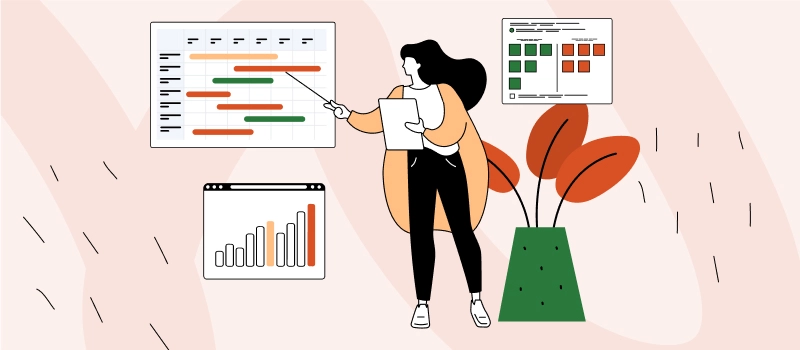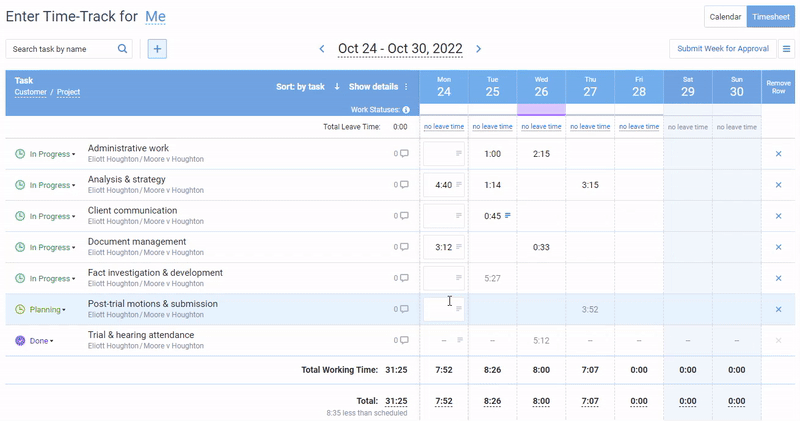
Workplace productivity has been the subject of countless studies, books, and online articles, but nine times out of ten, any discussion on how to increase performance at work comes down to that one common thread – time management.
This is hardly a coincidence, though. Most experts agree that if you wish to increase your productivity in any real way, mastering that oh-so-elusive skill of time management is critical.
But if you’re someone who’s just getting into the subject of time management, deciding where to start can be a bit tricky. The sheer abundance of hints, tips, and recommendations available online is simply overwhelming. But fear not, dear reader, for we have combed through the vast oceans of Internet knowledge to produce for you a list of what we think are the best time management techniques and practices out there.
Already inspired to become a master of time management? Begin the path of improvement by trying out some of the recommendations given in this post and be sure to check our time management guide to deepen your knowledge even more.
15 Best Time Management Tactics and Practices
Planning and Organizing
Planning is a vital part of time management. Without a clear idea of what you want to accomplish and when, without getting organized properly, you’re bound to waste time working on unimportant tasks, procrastinating, and just thinking of what to do next again and again. In this case, you may suffer due to decision fatigue, which is going to affect the quality of your performance in the wrong way.
Here are some practices that can help you avoid that:
1. Use lists and prioritize tasks
There isn’t a single time management system in the world that doesn’t involve making and using lists. We can only carry so much in our heads, so don’t rely on your memory – create a list (or two)! It can be a daily schedule, a simple list of people to call, or things to do during the month or week.
Prioritize the items on your lists by importance and urgency to know which ones you should tackle first. To help you separate the important from the urgent, take a look at Stephen Covey’s excellent time management matrix.
2. Group similar tasks together
When you have several tasks to complete, and some of them are similar (like phone calls, blog post writing, meetings with colleagues, etc.), it would be a lot more efficient to batch them together and dedicate a block of time from your schedule to working solely on them.
Time blocking is super effective in boosting productivity. The reason for that is simple – different tasks demand different types of thinking. So, use this fact to your own advantage and, while you’re still “in the zone,” knock out a couple of other similar tasks instead of switching to something different, which will then require you to refocus and start from scratch.
3. Stick to a schedule
Using your lists as a blueprint, create a daily, weekly, or monthly schedule, reserving reasonably sized time slots for all of your planned tasks and activities. Doing this will keep you focused and more efficient and ensure that you’re always on top of things and not wasting time wondering what to do next.
Sticking to a schedule can also be an excellent way to promote a healthier work-life balance, provided that you consider your downtime and breaks. Allowing yourself to have a little rest between tasks and after a hard workday will help you recharge and maintain a high level of productivity in the long term.
4. Set goals
To plan tasks and distribute your time in the best way possible, you need to keep the big picture in mind:
- What kind of results are you expecting to attain?
- What’s the main thing that keeps you engaged in work in the first place?
- In other words, what are your performance goals and objectives?
Goal setting is core to successful task prioritizing. Knowing what you want to achieve will help you distinguish significant tasks from everything less critical. And for better results, formulate SMART goals to avoid any uncertainty and make sure you remain on the right track.
5. Implement digital calendars
Though many of us still prefer to map out our schedules and to-do lists on paper, it is often much more efficient to use digital calendars for scheduling and planning. Such tools as Google Calendar can be accessed through multiple devices and integrated with your email account for streamlined scheduling of upcoming appointments and meetings. These tools also support the automatic creation of recurring events. Plus, you can always set reminders in your digital calendar to never forget anything.
Control
You can’t manage what you don’t measure, so time tracking is one of the most essential practices to adopt. Combine it with the planning and organizing approaches listed above for even better results.
6. Stay on track with a timesheet
Timesheets have been one of the most popular workplace time tracking tools and they still are but in a digital package.
The timesheet interface allows you to review your list of tasks for the week, keep track of the working time by days and the totals for the week, and keep an eye on task estimates and deadlines. You can also maximize the benefits of automated timekeeping software by building charts and reports that are provided by your time tracking system.

Forget about manual time tracking and get precise progress data with a fully automated browser extension, Time Management Assistant.
Focus
Focus is another factor defining how successful you are in managing time. There’s no point in designing elaborate plans and schedules if you regularly get distracted and fail to adhere to them.
Thus, consider the below practices in order to stay focused and concentrated on work:
7. Learn to say “no” and delegate
It’s not unusual to have too many commitments and things to do than you can realistically manage. Heavy workloads offer plenty of opportunities to learn how to juggle multiple projects at the same time for sure, but on the other hand, our resources are limited, and we simply cannot devote our full attention to multiple tasks all at once. Hence, don’t feel guilty saying “no” to certain things. Delegate some tasks and take on only the most important ones.
8. Keep meetings to a minimum
Meetings are great when you need to discuss work-related problems or check on your team’s progress. However, research data show that meetings are one of the biggest time wasters in the workplace, with top management spending on average 23 hours a week on them.
Besides, we can all agree that attending a meeting is hardly the best way to get things done. We’re not suggesting eliminating meetings altogether, but keeping them very brief and focused is a sure way to manage time well.
9. Minimize distractions
Find a quiet place, sit in a comfy chair, and put on some music to block out the office noise. Now, close all the browser tabs, set your phone on silent, put it away, and get to work. Direct all of your attention and energy to the task at hand. Immerse yourself in it. It’s just you and your work. Nothing else should matter and fight for your attention at that particular moment in time.
10. Choose single-tasking
Multitasking may seem like a good way to get everything done on schedule. However, in reality, it’s the #1 enemy of productivity. When we multitask, we constantly shift attention from one thing to another. And since it takes time to re-concentrate, by choosing to multitask, we lose much time.
To be more effective in whatever you do, become a single-tasker instead. Focusing on one piece of work at a time, you’ll not only complete much more but also increase the quality of performance.
11. Establish deadlines
When you have no time limits to attain a goal, you don’t see any barriers to postponing work. It means that your tendency to procrastinate may increase multifold without a deadline. Thus, to boost focus, strive to allocate a limited amount of time to each task at hand.
However, make certain your deadlines are reasonable. They shouldn’t cause too much pressure but must still keep you motivated. And to set realistic deadlines, master the art of task estimation – use historical data, comprehensive analysis, and precise calculations to forecast how many resources you need to invest in work. With accurate time estimates, finding the optimal deadline is never a problem.
Pass our quiz to learn whether you can increase your productivity even more.
Productivity
Many of us know that time management contributes to better productivity. Nevertheless, the relationship between productivity and time management is not so one-sided and is much more complex than that. In fact, by maintaining the right level of productivity, you’ll automatically begin to utilize time more efficiently.
Some of the best productivity-boosting practices that will help you improve time management are as follows:
12. Handle your productivity peaks wisely
A productivity peak is the period in a day when one has the highest level of energy and can stay focused more easily. According to a study, 11 a.m. is the most productive time for the majority of people. So, it makes total sense to concentrate on performing the most critical tasks during the first hours of the day, before lunch. The less significant and mentally demanding activities may be left for the afternoon and evening. As a result, you will show progress even in the most challenging and tedious types of work and meet your priority goals faster.
13. Make use of your idle time
We happen to have quite a lot of natural downtime throughout the day when we’re not doing anything: commuting, standing in a supermarket line or waiting at the doctor’s office. It may seem like just ten minutes of downtime don’t really matter, but they do – it’s ten fewer minutes to engage in something useful.
Therefore, try to take advantage of your idle time to do useful things. Any things, really – read a book, listen to a lecture or a podcast, watch an educational video on YouTube. A vast body of human knowledge is readily available to you on a device you’re holding in your hand ever so often. Thus, there’s no good excuse to kill time while sitting in traffic or waiting for your flight in an airport.
14. Avoid overwork
We can’t be productive twenty-four hours a day, seven days a week. In fact, when you overwork and rarely give yourself an opportunity to relax, your productivity levels decline drastically.
To minimize stress and psychological strain, to stay energetic and motivated, take a short and quality break once in a while. Besides, try not to work more than eight hours a day / forty hours a week when possible – there’s a high chance you won’t perform as effectively when spending more hours on your professional activities.
15. Apply collaboration tools
If you work in a team, collaboration is an intrinsic part of your everyday reality. However, there are many barriers to effective collaboration and communication, and they may slow down both individual and collective performance a great deal. One of the best ways to overcome those barriers is by adopting high-quality software tools.
Many kinds and categories of collaboration software exist today: video conferencing tools, document management platforms, project management apps, and more. Explore the market and select a type of software that perfectly meets your team’s needs. As an outcome, you’ll improve your information exchange experience, avoid significant time wasters, and boost productivity.
15 Best Time Management Techniques for Productivity at Warp Speed
1. Time Tracking
To utilize time effectively, you need to know how much of it you spend on different tasks and activities, and the easiest way to stay in the know of this matter is by adopting a multifunctional time tracker like actiTIME.
How does it work?
Time tracking with actiTIME involves merely five simple steps:
- Organize your projects, create tasks, set deadlines, priorities, estimates, etc.
- Assign work to employees.
- Track time spent on tasks using a variety of methods: manual-entry timesheets, one-click timers in the mobile app, and a fully automated browser extension.
- Review and approve timesheets once filled.
- Analyze the collected data to improve resource utilization and team productivity.

Benefits:
actiTIME assists in collecting all the data you need to analyze your productivity trends, identify any time wasters, and make corrections to your behaviors and workflows if needed. Moreover, it enables users to monitor their performance progress and comply with original estimates without a hitch. Overall, the rich functionality of this timesheet tool makes it an indispensable helper in following your work plans, to-do lists, and schedules infallibly.
2. The Ivy Lee Method
To-do lists are one of the most popular time management techniques we utilize to plan tasks. However, having an endless list of objectives is often overwhelming and rather pointless. Like in the case of any effective time management technique, there must be a well-functioning system behind the making of to-do lists, and the Ivy Lee Method is here to provide it to you.
How does it work?
The technique comprises five simple steps:
- At the end of the workday, create a list of the six most important tasks you want to complete tomorrow. Six is the maximum. However, you can write down three or four things if you wish.
- Prioritize all the items on your list. Task 1 will be the most crucial of them, and Task 6 – the least significant.
- At the beginning of the next workday, focus on Task 1 and jump on Task 2 only after it’s done.
- Move throughout the list in the same manner. If some items are left on the list by the evening, include them in your to-do list for the next day.
- Repeat the process throughout the week.
Benefits:
The Ivy Lee Method has been in use for over a hundred years, and during this period, it proved to be very useful. This simple time management technique not only keeps you organized but also promotes productivity and reduces decision fatigue.
3. Priority Pyramid
This prioritization method was created by Tomas Rybing. It is based on the Kanban principles and works as a priority filter.
How does it work?
To make use of the time management technique, draw a pyramid and divide it into three blocks: Priority 1 (P1), Priority 2 (P2), and Priority 3 (P3), like in the picture below. Then, write the names of all your tasks on sticky notes and distribute them across the different sections of the pyramid. Less important and urgent tasks should be placed at the bottom and your main priorities – at the top.
This way, the Priority Pyramid helps you identify all the tasks you need to focus on first as you’re working (the P1 items). Once completed, these tasks move out of the pyramid and are marked as done. Meanwhile, the P2 and P3 tasks gradually go upwards and take their place at the top.
Benefits:
This workload visualization principle makes the Priority Pyramid an excellent tool for planning and organizing the work process. Moreover, it assists in staying focused on the essentials.
4. To-Don’t Lists
Tired of never-ending to-do lists? Try creating a short but helpful to-don’t list then. The idea behind this time management technique is simple – instead of writing down all the things you need to accomplish, crossing them off, and continually repopulating your list with new items, just identify several activities, tasks, or habits that you could strike out your life once and for all.
How does it work?
- Begin by considering your long-term goals and the daily tasks that contribute to or detract from these objectives. Understanding what you’re working towards will help you identify what doesn’t serve your purpose.
- Note down the activities that consume your time without providing significant value. The goal here is to focus on things that make you utilize time ineffectively: playing online games while at the office, working on weekends and neglecting family needs, checking on new emails every fifteen minutes, etc.
- Think about behaviors that hinder your productivity or well-being, like procrastination or skipping breakfast. Recognizing these can help you tailor a more beneficial daily routine.
- Once you have a list, prioritize it based on the negative impact each item has on your life. Start by eliminating or reducing the most detrimental activities first.
- Implement changes gradually. Trying to avoid all your listed activities at once can be overwhelming. Instead, focus on one or two changes at a time to gradually build better habits.
- Regularly revisit your to-don’t list to reflect on your progress and adjust as necessary. Life changes, and so will your priorities and challenges.
Benefits:
By paying attention to stuff that eats up the time you could spend more productively, you have a greater chance to modify your behaviors in a positive way, improve your work-life balance, and show more progress at work.
5. The Eisenhower Matrix
Many of us tend to prioritize tasks based on urgency alone. However, according to Stephen Covey, the creator of the Eisenhower Matrix, such an approach is counterproductive and only makes us spend less time on crucial things.
How does it work?
To get out of the urgency trap, analyze your tasks in terms of both urgency (the need to take immediate action) and importance (the extent of a task’s contribution to your long-term goals). Then, identify which part of the Eisenhower Matrix these tasks fall under:
- Do First – Urgent and important tasks that have well-defined deadlines. The consequences of failing to complete them on time are usually quite severe and unpleasant. Example: handling a software engineering project for a client.
- Schedule – Important but not urgent things with no or overly long deadlines. Everything that’s easy to procrastinate on but helps you fulfill your objectives and goals. Example: professional development activities.
- Delegate – Not essential but urgent tasks that have to be completed but can be done well by somebody else. In other words, a routine type of work. Example: emailing, blog post scheduling.
- Eliminate – Neither essential nor urgent activities that only distract you from actual work and slow down the progress. Example: mindless screen time, and video games.
Benefits:
The Eisenhower Matrix is particularly useful in case you have intense workloads. It helps understand which responsibilities are worth your full attention and which can be postponed without much harm. In other words, it fosters a better work-life balance, reduces stress, and makes you more organized.
6. Eat the Frog
To ensure you advance towards your goals and don’t spend all your time on insignificant matters, you may want to Eat the Frog. Even if you’re a vegan, there’s no reason to worry – despite the name, this time management technique is absolutely friendly to your kind.
How does it work?
Take a few minutes of your time in the evening to identify the most demanding and vital task for the following day, and then commit to it first thing in the morning. That’s it.
Benefits:
By repeating this two-step process every day throughout the week, you’ll be less prone to postpone the job you’re reluctant to do, procrastinate, and show fake productivity. Besides, by setting just one priority and focusing on it during your productivity peak hours, you’ll eliminate distractions and increase your performance multifold.
7. Time Blocking
Time blocking is all about dividing the whole of your working time for a day into several blocks of uninterrupted focus and allocating each of these blocks to either one task or a series of similar activities.
How does it work?
- Create a work plan for the day.
- Prioritize tasks and estimate how much time it will take you to complete them.
- Develop a schedule: define time blocks for each piece of work and place the ones created for the priority tasks at the beginning of your day.
Benefits:
A schedule designed following this principle promotes single-tasking and reduces the periods of “open-ended reactivity” that make us distracted and kill focus. Thereby, time blocking produces immense benefits, including better work organization, higher efficacy, and a significant productivity boost.
8. Time Boxing
Time boxing can be regarded as a cousin of time blocking, even though these two relatives are quite distinct from each other in a major way.
While time blocking encourages you to schedule several hours for a task (without the stringent cap), time boxing requires you to enclose tasks within a fixed and non-negotiable “box” of time.
This means you should commit to working on a task for, say, 30 minutes, and when that time is up, you must stop, regardless of your progress. It’s akin to a sports game with a fixed duration – the aim is to score as much as possible before the final whistle.
How does it work?
- Decide how much time you’re willing to dedicate to each task from your to-do list. Use appropriate time estimation techniques to keep it more realistic.
- Set a timer to mark the beginning of your time box. Work on the task with undivided attention until the timer goes off – this is the time to silence notifications and focus solely on the task at hand.
- Once the time is up, evaluate your results. If the task is completed, you can reflect on the process and perhaps adjust future time boxes based on this experience. If it’s not, decide whether it needs another time box or if it’s time to move on to something else.
Benefits:
This time management technique not only fosters a sense of urgency and focus but also helps in battling the notorious foe of productivity – perfectionism. It also prevents your attention from bleeding over the allocated time, which promotes discipline in managing your schedule.
9. The Pomodoro Technique
Naturally, people cannot stay 100% focused for an extended period. Thus, repeatedly working in shorter intervals with small breaks in between usually leads to better performance results than staying on a task for three or four hours in a row.
That’s why the Pomodoro Technique is so effective. Plus, it is reasonably easy to implement.
How does it work?
- Choose a task and set a timer for 25 minutes.
- Concentrate on that task until the time is up.
- Give yourself a 5-minute break.
- Work in the same rhythm for three more intervals.
- After the fourth interval, take a longer 20-minute break.
You may utilize a simple kitchen timer or a smartphone timer to operate the Pomodoro Technique. But using a specialized Pomodoro app is an excellent option as well. Along with timer functionality, this type of software often includes features for smart scheduling, distraction blocking, and task management that foster an extra productivity boost.
Benefits:
This time management technique helps reduce mental fatigue, encourages sustained concentration, and enhances time management by urging you to work with the time you have, rather than against it.
10. The Flowtime Technique
The Flowtime technique could very well be mistaken for a new-age meditation practice, but alas, it’s just a variation of the Pomodoro method, inviting you to focus on work for an extended period of time rather than 25-minute intervals.
How does it work?
- Select a task you wish to focus on. The key is to zero in on one task to channel your energies effectively.
- Start working on your chosen task with undivided attention. The goal is to immerse yourself until you naturally feel the need for a break.
- Keep track of how long you’ve been working and jot down your mood or level of engagement at intervals. This informal log aids in recognizing your optimal work and rest periods over time.
- When you sense your concentration waning, it’s time to pause. The beauty of Flowtime is its flexibility – there’s no strict schedule for breaks. You break when your mind or body signals the need.
- After the break, take a moment to reflect on what you accomplished and how you felt during the session. Then, decide if you want to continue with the same task or switch to a new one. Reset your focus and start the next cycle of uninterrupted work.
Benefits:
This mindful time management technique requires you to listen to your needs and encourages you to work in natural cycles of focus and rest, which eventually maximizes efficiency and helps to prevent burnout. It fosters deep concentration, enabling you to accomplish more in less time.
11. The Seinfeld Method
Need to develop a good habit or accomplish a long-term goal? Then, the Seinfeld Method is worth your consideration.
“Practice makes perfect” is the major idea behind the technique, and it encourages you to create an unbroken chain of productive behaviors by engaging in a purposeful practice consistently – every day over several months or a year.
How does it work?
Here’s what you have to do to make use of the Seinfeld Method:
- Get a visual calendar.
- Put it in a place where it’s easy to review and access.
- Every day, practice the skill you want to develop or work on the task that brings you closer to your goal (even if you’re unmotivated or demonstrate poor results). Note that your daily practice objective must have measurable criteria. For instance, you may want to read 30 pages a day or learn biology for an hour a day.
- Mark each date you practiced on in your calendar. Use a simple marker for paper calendars or an in-build color code system in a digital app.
- The aim of the technique is to build a chain of completed daily objectives. Thus, you have to persist in practicing for as long as you can.
Benefits:
Seeing an unbroken chain of fulfilled objectives on the calendar is highly motivating. It makes you feel more accomplished and encourages you to keep going and progress. With the Seinfeld Method, you won’t waste time in vain. Instead, you’ll use it up on the stuff that matters to you.
12. The 10-Minute Rule
Let’s be honest, most of us don’t glow with motivation at all times, especially if we have to work on something boring and challenging. As a result, we put off many useful and goal-oriented activities for later, and in many cases, they remain unfulfilled – forever. However, this disappointing tendency to procrastinate has a cure, and it’s called the 10-minute rule.
How does it work?
If you experience a sense of dread or any other unpleasant emotions when faced with a demanding job, when you just can’t find the inner strength to commit to it for an extended period, talk yourself into dedicating merely 10 minutes to working on it.
Benefits:
10 minutes is a tiny fraction of time. You can do almost anything for 10 minutes. Therefore, the 10-minute rule helps you fight laziness, apathy, and aversion towards some tasks. Plus, whenever you start working, even if it’s just for 10 minutes, you increase your chances to continue doing so for more time and complete that dreadful chore faster.
13. BuJo
BuJo (or the Bullet Journal), encourages you to live a more organized and productive life. However, it’s much more than simply a planner. It’s a mindfulness practice disguised as a productivity tool.
How does it work?
To make use of the BuJo method, you simply need to build a journal consisting of the following parts:
- Index page(s): The first two to four pages are meant to list and categorize the contents of your journal, helping you navigate it swiftly.
- Future log: This is where your forward planning takes shape. Divide pages into future months where you can jot down events, goals, or appointments coming down the line.
- Monthly log: At the start of each month, create a page to overview your month. It’s a snapshot of what’s to come, and a space to set monthly goals.
- Weekly/daily logs: Here’s where the rubber meets the road. Plan your weeks or days with as much detail as you like. Some prefer a simple to-do list, while others decorate and elaborate with themes and colors.
- Collections: These are themed pages where you track, organize, or jot down specific things like reading lists, gratitude logs, or workout plans. It’s your BuJo’s customizable feature – make it feel like you.
Benefits:
This technique enables you to better plan and organize tasks, events, and notes in a highly customizable manner. By encouraging you to reflect upon your goals and achievements in a structured yet personal space, it fosters mindfulness and ignites creativity.
14. Pareto Analysis
Pareto analysis (often dubbed as the 80/20 rule) is a fascinating principle suggesting that, in many situations, 80% of effects come from a mere 20% of causes.
Imagine you have a garden full of fruit trees, where just 20% of those trees might produce 80% of the fruit.
This principle, named after economist Vilfredo Pareto, who initially observed it in relation to land and wealth distribution in Italy, has since transcended economics, finding its place in business, health care, and even personal time management.

How does it work?
To test Pareto analysis in action, follow these steps:
- Jot down all the tasks or problems that consume your day.
- For each task or problem on the list, assign a score based on its importance or impact on your overall goals.
- Arrange the tasks in descending order based on their scores.
- Identify the top 20% of tasks that will have 80% of the impact on achieving your goals.
- Prioritize and devote more time to these crucial tasks.
Benefits:
Analyzing your activities based on the 80/20 rule helps identify time wasters, prioritize objectives more effectively, and ultimately build an optimal daily routine that aligns with your personal and professional goals just perfectly.
15. Getting Things Done
The Getting Things Done (GTD) technique, conceived by productivity guru David Allen, is perfect for those who want to achieve Zen-like organization in their personal and professional lives. It goes beyond just getting things off your to-do list – it’s about freeing up mental space to allow creativity and productivity to flourish.
How does it work?
The technique hinges on five simple steps:
- Capture: Start by collecting every task, idea, or project that’s on your mind. Whether it’s a stress-inducing deadline or a fleeting thought about a potential hobby, write it down. This step clears your mind, transforming mental clutter into a tangible, actionable list.
- Clarify: Sift through the identified items with a critical eye. Ask yourself, “Is this actionable?” If not, file it away, discard it, or put it on hold. For actionable items, decide on the next steps and categorize them accordingly. It’s a process of making the vague more concrete, and the overwhelming more manageable.
- Organize: Arrange these actionable items into lists that make sense to you. This might include categories like “Work,” “Personal,” “Errands,” or “Projects.” This lets you turn chaos into order, providing a clear view of what needs to be done and when.
- Reflect: Periodically review your lists. This can be daily, weekly, or as often as needed to keep you on track. The key here is to ensure that your lists are current and that nothing slips through the cracks. It’s a moment to reassess, reprioritize, and reinvigorate your commitment to your tasks.
- Engage: With everything laid out clearly, choose a task and jump in. The beauty of GTD is that by the time you reach this step, you know exactly what you need to do, and you can engage with it fully and directly.
Benefits:
The GTD method assists in choosing your actions with confidence and clarity. It helps to boost productivity not through sheer effort but through smarter, more focused energy. This way, GTD promises a more focused and tranquil state of mind along with a more organized desk.
Conclusion
Each of the 30 time management techniques and practices discussed above offers a unique lens through which to view your daily workflows, schedule tasks, and beat procrastination. Implementing these techniques could very well be the key to achieving all your desired goals, but the real magic happens when you leverage the right technology to stay organized and track how you use your time.
actiTIME offers the perfect blend of functionality and simplicity in this regard, which makes it an indispensable ally in your search for peak productivity.
Why wait to enhance your approach to time management? Start being more productive and efficient today – sign up for a free actiTIME trial now.












































